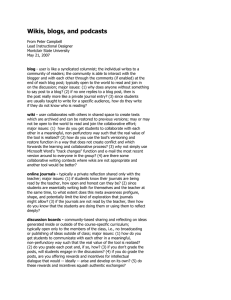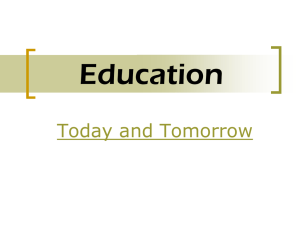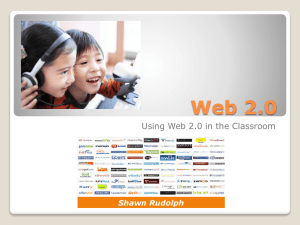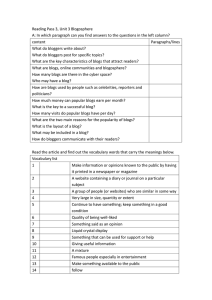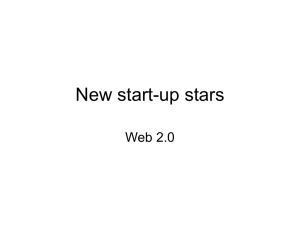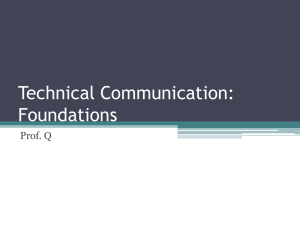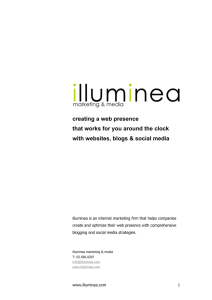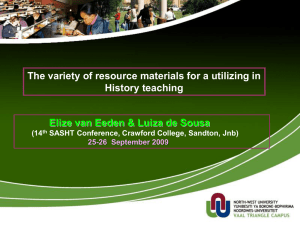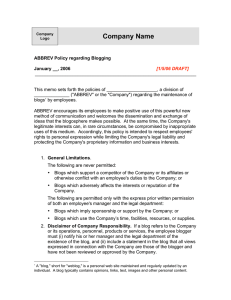Social Media in Hospitality
advertisement
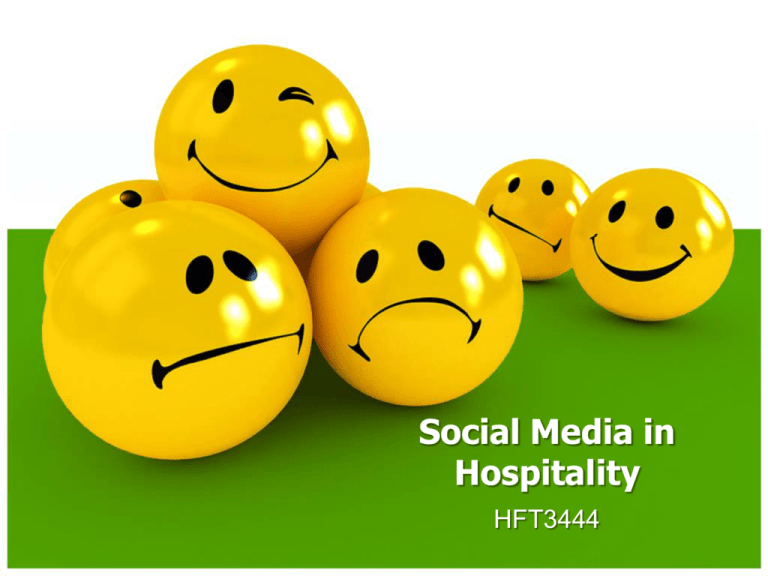
Social Media in Hospitality HFT3444 What is Social Media? Definition of Social Media Social Media can take many different forms, including Internet forums, weblogs, social blogs, wikis, podcasts, pictures and video. Technologies include: blogs, picture-sharing, vlogs, wall-postings, email, instant messaging, music-sharing, crowdsourcing, and voice over IP, to name a few. 1 1http://en.wikipedia.org/wiki/Social_media What is social media and Web 2.0? • • • • • • Harnessing collective intelligence Trusting consumers as co-developers Engaging consumer experiences Participation Trust economy Word of mouse The old vs. the new Web 1.0 Web 2.0 Eyeballs Hands Britannica online Wikipedia Personal websites Blogging CMS Wikis Directories Tagging Stickiness Syndication Instant messenger Twitter Conferences Unconferences Shared Knowledge • Web 2.0 is a way of thinking about how knowledge is created, shared, managed, and leveraged using technology. Web 1.0 vs. Web 2.0 Web 1.0 was about reading Web 2.0 is about writing Web 1.0 was about owning Web 2.0 is about sharing Web 1.0 was about companies Web 2.0 is about communities Web 1.0 was about home pages Web 2.0 is about blogs Web 1.0 was about portals Web 2.0 is about RSS and syndication Web 1.0 was about taxonomy Web 2.0 is about “tags” and folksonomy Web 1.0 was about Netscape Web 2.0 is about Google Web 1.0 was about wires Web 2.0 is about wireless Web 1.0 was about dialup Web 2.0 is about broadband Adapted from www.joedrumgoole.com Social media is a conversation between people… Supporters Participants Donors Audiences Opinion Leaders The conversation is NOT controlled… Not organized… Not on message… SOCIAL MEDIA USE IS GROWING 184 million bloggers 73% of active online users have read a blog 45% have started their own blog 57% have joined a social network 55% have uploaded photos 83% have watched video clips 39% subscribe to an RSS feed Source: Universal Figure 8.1 The emergence and rise of mass social media. (Source: Hinchcliffe, D., Web 2.0 Blog, web2.wsj2.com) Why Now? • Better access to technology for the average user – higher speed Internet connections, faster computers, better cell phones, etc • Millennials are known as “digital natives,” having lived with the internet all of their lives. • Young people are beginning to expect and demand their employers and others to use online media to recruit, communicate, engage, and manage knowledge. • Those who use technology will outlast those who don’t. Why does it matter? • Web 2.0 and social media technologies are about connecting people information and each other so they can better create and collaborate. • Information sharing. • Risk reduction • Web 2.0 and social media technologies will help strengthen and enhance traditional communication strategies. What am I missing out on? • Viral nature of Web 2.0 and social media technologies • Improved customer service • Increased storytelling Enterprise Social Network Interfaces • Utilize existing social networks • Create in-house network & then use as employee communication tool & form of knowledge management • Conduct business activities • Create services • Create and/or participate in social marketplace Web 3.0 The Web 3.0 is the next paradigm shift of the internet taking the best of web 2.0, including rich internet applications and social media, and bringing them to mobile devices. Information is searched for, filtered, personalized and delivered to end users based on preferences, biofeedback and location. 1 1http://www.mindgrub.com/web3.0 Definition of the Semantic Web Semantic Web is an evolving extension of the web 3.0 where information is tagged in relation to use and context so that it and similar information can be delivered more effectively to humans and machines Location Enabled Social Media Google Latitude Loopt, Flagr, Whrrl, Buzzd, Zhiing, Urban Spoon Case Study: Loopt Case Study: Zhiing LBS Location Based Services (LBS) information services accessible with mobile devices through a mobile network and based on location LBE Frameworks + Content LBE Framework Case Study: viaPlace Types of Location Based Experiences • Restaurant Guides and User Comments • Transportation Information • Golf and Recreation mapping • Historical and Tours • Real Estate Home Buying Issues For Social Network Services • • • • • Lack of privacy controls Inappropriate language translations among countries Fierce competition for users Prey to illegal activities Cultural objections may become volatile Enterprise Social Network Interfaces • Utilize existing social networks • Create in-house network & then use as employee communication tool & form of knowledge management • Conduct business activities • Create services • Create and/or participate in social marketplace Travel 2.0 • The Internet is an ideal technology for travel. It offers a vast information resource, immediate convenience and interaction that can provide a very personal experience. As the Internet reaches to every house and business, it will find a huge market of travelers looking for information "Just Beyond their Imagination, and only a click away". • Today, Travel accounts for a nearly 28,5 % of all annual online transactions in the world, at 150 billion usd • According to a just September 2008 released study by Prophis eResearch, an estimated 19 million online Americans have visited one of the top ten travel 2.0 traveler community based sites such as TripAdvisor in the past 12 months. • Yahoo Travel in a recent survey indicated 61% of people go online for travel The New Travel Order User Generated Reviews From articles and archives to exhaustive details towards user generated content on social networks and an unbiased reviews and referrals paradigm Travel Blogs Content still key, but now Shared Experiences Inspire Travel Hotels 44 CVBs 45 Restaurants

